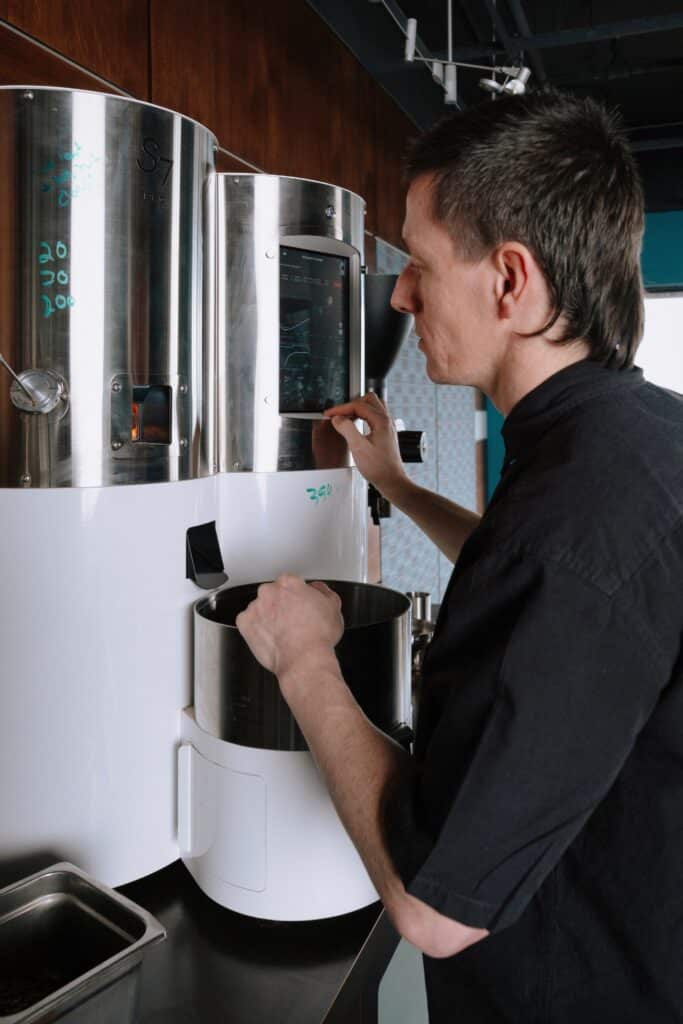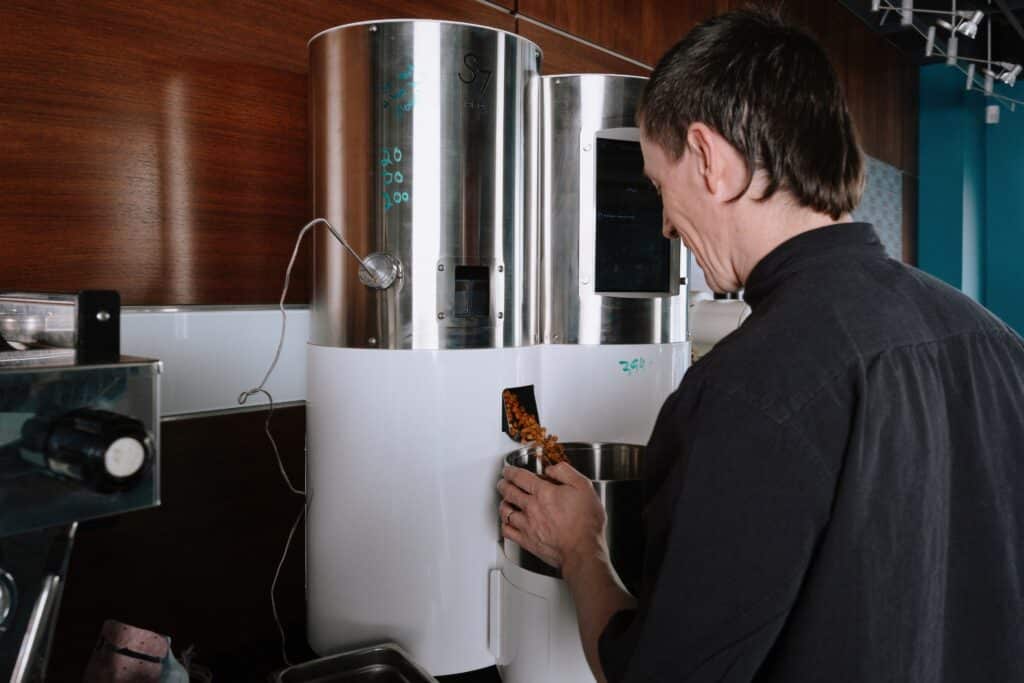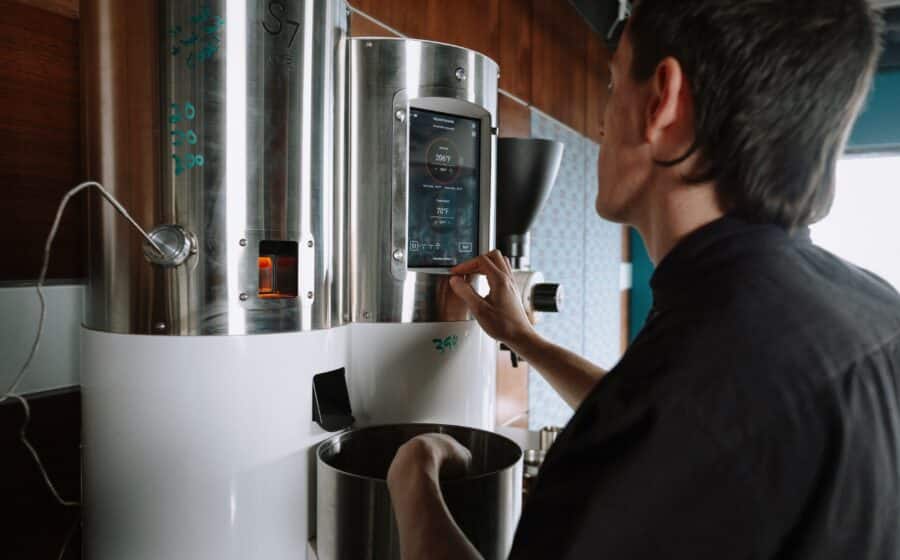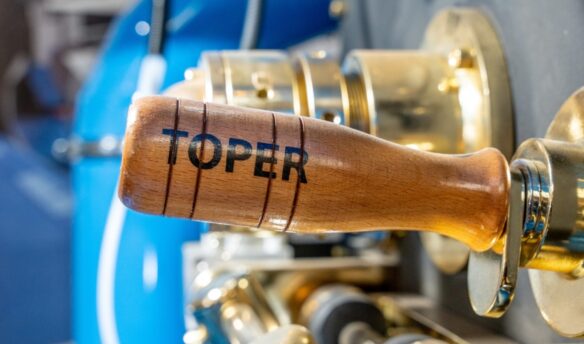As the impacts of climate change come into clearer focus, many of us are increasingly eager to make positive environmental choices. 60% of US consumers report they would be willing to pay more for sustainable products—and the specialty coffee industry is working to answer the call.
But in a time when the word “sustainable” can feel ambiguous and greenwashing—the practice of promoting a product or method as more climate-friendly than it is—becomes increasingly more prevalent, people are looking for companies to take concrete and measurable steps to reduce their carbon footprint and implement sustainable solutions. One of the most recognized and impactful ways for a business to reduce its operational carbon footprint is to shift from fossil fuels to cleaner energy sources.
One of the ways the coffee industry is looking toward implementing more sustainable options is through electric roasters. Big industry names like Probat now offer both electric and gas-powered roasters, alongside relative newcomers specializing in electric roasters, like Bellwether and Stronghold Roasters. Collectively, they are catering to a growing interest in more sustainable supply chains, lower carbon footprints, and streamlined roasting processes based on electric roasters’ low barrier to entry.
When it comes to tradition versus novelty, a lot of people feel tied to the way things have always been done—and gas-powered roasters have been the standard for decades. But with more people asking questions about environmental responsibility and how sustainably made (or roasted) their products are, the question becomes: is electric roasting here to stay?
The Shift from Gas to Electric
Although you’ve likely heard experts and researchers talk about the need for humans to rely less on fossil fuels for years, we’re still seeing these battles happen in real time. Recently, more and more people are discussing electrification, or “using technologies such as vehicles or heat pumps that operate with electricity instead of burning fossil fuels such as oil, gas and coal.” The US Green Building Council says, “Electrification is one of the most important factors in decarbonizing our buildings. Decarbonization is important because building operations are responsible for 31% of energy-related CO2 emissions in the US, and nearly half of all homes rely on natural gas as their primary heating fuel.”

The topic of electrification has recently fired up debate on gas-powered stoves in U.S. households. For example, legislators in California and New York have moved to limit gas hookups and sales of gas stoves because using gas indoors emits pollutants like nitrogen dioxide, carbon monoxide, particulate matter, and even formaldehyde, and the Inflation Reduction Act, introduced by lawmakers in 2022, would provide incentives for installing or upgrading to electric ranges. Although these moves are widely seen as a way to protect both human and environmental health, they haven’t been without backlash.
Wherever you stand on the gas-powered stove debate, similar questions about renewable energy have made their way into the coffee industry, particularly when it comes to roasting, a process that’s relied almost primarily on gas power for decades.
Coffee roasting has a long and storied history, but the chapter on modern roasting begins in 1824 in the United Kingdom when Richard Evans took out a patent for the first large-scale coffee roaster. For over a century afterward, most coffee roasters were gas-powered. Although people continued to innovate on Evans’ original design, it wasn’t until the 2010s that electric roasters began sharing space in coffee roasting facilities alongside their gas-powered counterparts.
One of the first businesses to make a big splash in the electric roasting market was Bellwether Coffee, a US-based electric roaster manufacturer founded in 2013. The company believes recognition of their ventless, all-electric coffee roaster by the Specialty Coffee Association (SCA) put renewed focus on electric roasting.
“Since Bellwether Coffee won the SCA Best New Product in 2019, electric roasting has gained more traction, which can be attributed to a variety of factors, including greater sustainability efforts and advancing technology,” says Grayson Caldwell, Bellwether’s Head of Sustainability & Impact.
Along with new businesses like Bellwether, whose operation centers on its patented electric roaster, many coffee roasting companies have begun incorporating gas-powered versions of their roasting machines. Even Probat, a German roaster manufacturer that released its first gas-powered drum roaster in 1884—and whose gas-powered roasters are so prized that many seek out vintage models for their roasting facilities—has launched its own electric roasters. Probat’s P05 roaster, powered by renewable hydrogen, won the same award as Bellwether, Best New Product, at the SCA Expo in 2023.
But electric roasters have nearly a hundred years’ worth of precedent to contend with, and most roasting facilities still rely on gas. Generally speaking, roasters can be divided into two styles: drum (which uses conduction heat) and fluid bed (which uses convection heat), and both can be designed to run on gas or electric power. Gas-powered roasters require coffee roasting facilities to install gas lines and ventilation systems. Though this has a higher initial cost, gas often gives roasters a higher degree of control over the roasting process.
“If you preheat an oven to 400 degrees, then put food in the oven for five minutes, only to realize you want to lower the temperature to 300 degrees, how your oven slowly drops in temperature would be comparable to an electric roaster,” says Baylee Engberg, Managing Director of #shestheroaster, an organization that promotes scholarships and opportunities for self-identifying women and non-binary people interested in roasting coffee. “Conversely, if you have food cooking on a gas range on high and decide to turn the gas to low, you’ll instantly see that result, which is more comparable to a gas roaster.”

Engberg’s example illustrates one of the primary differences in how gas roasters operate versus electric: the temperature in a gas roaster can be changed quickly by manipulating the gas source, while electric has to slowly ramp up or down. Though the use of gas power can lead to more direct carbon emissions, some consider gas to be a more efficient power source because it responds quickly to changes, while others say electricity is more efficient because not as much energy is lost during the heating process (this is mainly true of renewable resources; electricity generated by natural gas is about 44% efficient). But does using gas or electric impact the quality of coffee?
“One could argue that the operator has less control [with an electric roaster] than a gas or air roaster, but I personally don’t believe that would sacrifice quality,” says Engberg. “If the profile is done well and is repeatable, then there are no wrong or right answers in roasting.”
Ben Put is the co-founder of Monogram Coffee in Calgary, Canada, and he sees electric roasting positively impacting coffee quality. “We really like the flavor profile that comes from high-quality electric roasters: clean and articulate flavors and well-developed acidity,” he says. Monogram uses both an electric-powered Stronghold and a gas-powered Loring to roast coffee for their four cafe locations and wholesale business.
But choosing between an electric or gas roaster isn’t necessarily about which is better for your coffee, and both can serve a roastery well. “I believe there’s a time and a place for all types of roasting machines,” Engberg says, noting the choice between electric and gas has more to do with consistency rather than preferring one style over another. “Often, companies use an air or an electric sample roaster, then try translating those sample roast profiles to their gas production roaster and find they cannot achieve the same result. If you intend to buy an electric roaster, I recommend finding a correlating sample roaster so it relates well to your production roaster.”
The Environmental Benefits of Electric
If electric roasters can offer comparable coffee quality to gas-powered roasters, one of the most compelling reasons to consider electric is for the potential environmental benefits.
“The industry is finally recognizing the environmental implications of gas roasting and is seeking a more eco-conscious alternative,” Caldwell says. “The math does not lie—gas roasting has a significant role in carbon emissions, with the US alone consuming more than 8 billion pounds of coffee annually.”
One could argue that the operator has less control [with an electric roaster] than a gas or air roaster, but I personally don’t believe that would sacrifice quality. If the profile is done well and is repeatable, then there are no wrong or right answers in roasting. baylee engberg
At this rate, the consumption of 8 million pounds of coffee “creates an alarming 19.6 billion pounds of carbon emissions each year,” says Caldwell. This is roughly equivalent to the carbon emissions produced by 2,018,761 gasoline-powered passenger vehicles in one year, according to the US Environmental Protection Agency’s Greenhouse Gas Equivalencies Calculator.
Roasting currently makes up about 15% of the coffee industry’s carbon footprint. Bellwether recently commissioned a third-party organization called Boundless Energy to conduct a report on the impact of their machines (Fresh Cup was given access to a copy, but the report is not currently available on their website). Their data found that even in places where the electric grid uses fossil fuels, using a Bellwether machine is a “cleaner” way to roast than natural gas. Caldwell says that a shift towards electric roasting could reduce emissions by about 87% and more when paired with renewable power sources like solar or wind power, which convert energy into electricity more efficiently.
Current trends also indicate that electric-powered tools and appliances will become more prominent. “With nationwide gas bans looming and global climate agreements being enacted,” says Caldwell, “businesses have to start future-proofing their model to remain economically viable and attractive to consumers, who are continuing to spend their dollars with companies that align with their own values.”
Considering an Electric Roaster? Here’s What You Should Know
The gap between electric and gas-powered roasters might not be as vast as you think. “The two biggest takeaways I have found from an electric roaster is that it is arguably more environmentally friendly because it doesn’t emit any fumes and that adjustments made while roasting make less of a dramatic impact on the process,” Engberg says.
For businesses that are still green to coffee roasting, Caldwell believes electric systems provide an accessible entry point. “There is no need to install gas lines and ventilation systems, which can be costly and time-consuming.”
Put mentions that electric roasters are also harnessing technology in design, noting Stronghold’s easy-to-understand user interfaces as a big advantage. “More Monogram staff are able to roast on the Stronghold, both because it has an automation feature and because the user interface is a lot more approachable and intuitive than traditional gas roasters,” he says.
But that doesn’t mean you should rush to get an electric roaster—at least not without trying one out. “If you’re looking to buy an electric roaster, try out a sample roaster first,” Engberg says (many sample roasters, or roasters designed to hold small amounts of coffee for sample batches, are electric-powered).
Most electric roasters are a bit smaller than their gas relatives. This smaller batch size [means] we can purchase smaller lots from producers we normally had to pass over. Ben put
Put says that using both styles of roasters—despite their differences—hasn’t been a challenge for Monogram. “I believe that switching between roaster types is not too difficult if you have good roasting practices and a clear understanding of your roast philosophy and style,” he says. “After that, it’s just a matter of determining optimal batch sizes and initial heat settings.”
For Monogram, Put says that the Stronghold is better suited for smaller batch sizes, which allows them to buy coffees from producers they normally couldn’t purchase from. “Most electric roasters are a bit smaller than their gas relatives. This smaller batch size [means] we can purchase smaller lots from producers we normally had to pass over.”
Gas-powered roasters have over a century of precedent and tradition fueling the coffee industry, while electric-powered roasters are just beginning to experience more widespread adoption. With so many roasting companies—both new and established—rushing to develop electric-powered roasters, it can feel like this nascent movement is just a trend, something that will billow out in a few years before the next roasting innovation comes to light (A roaster powered by coffee? Apple cider vinegar? Or maybe one powered by your own sense of self-satisfaction?)
Despite the differences between electric and gas, electric is here to stay and will continue to offer new possibilities. Smaller roasters can clear the daunting overhead associated with gas-powered roasters with electric-powered machines that require a simple power source; more roasters, like Monogram, may be able to buy smaller lots of coffee and strengthen their relationships with farmers. Perhaps most importantly, electric roasting has helped open a dialogue on the environmental impact of roasting and gives roasters more options to consider for their coffee.
Photos by Allison Seto















